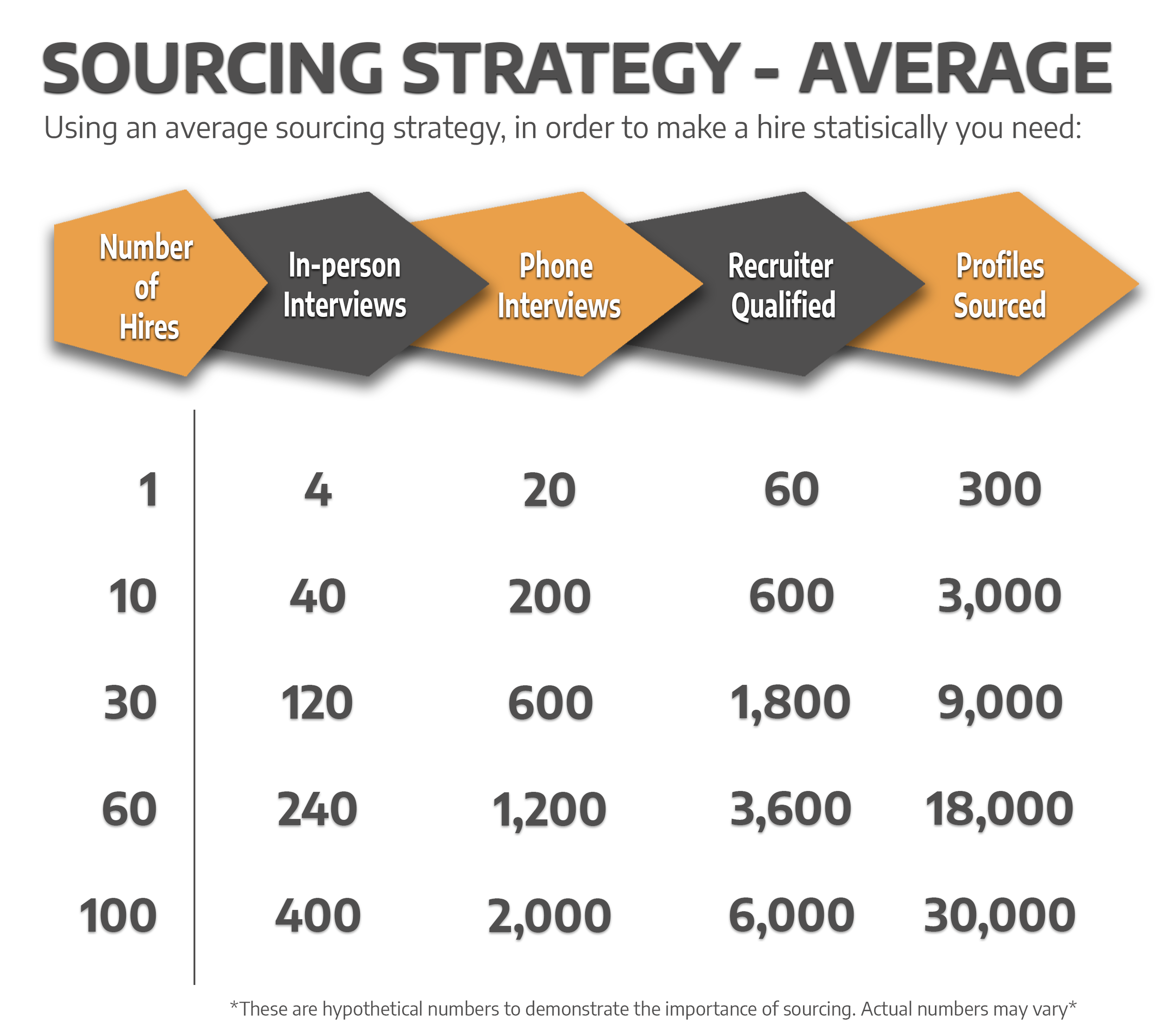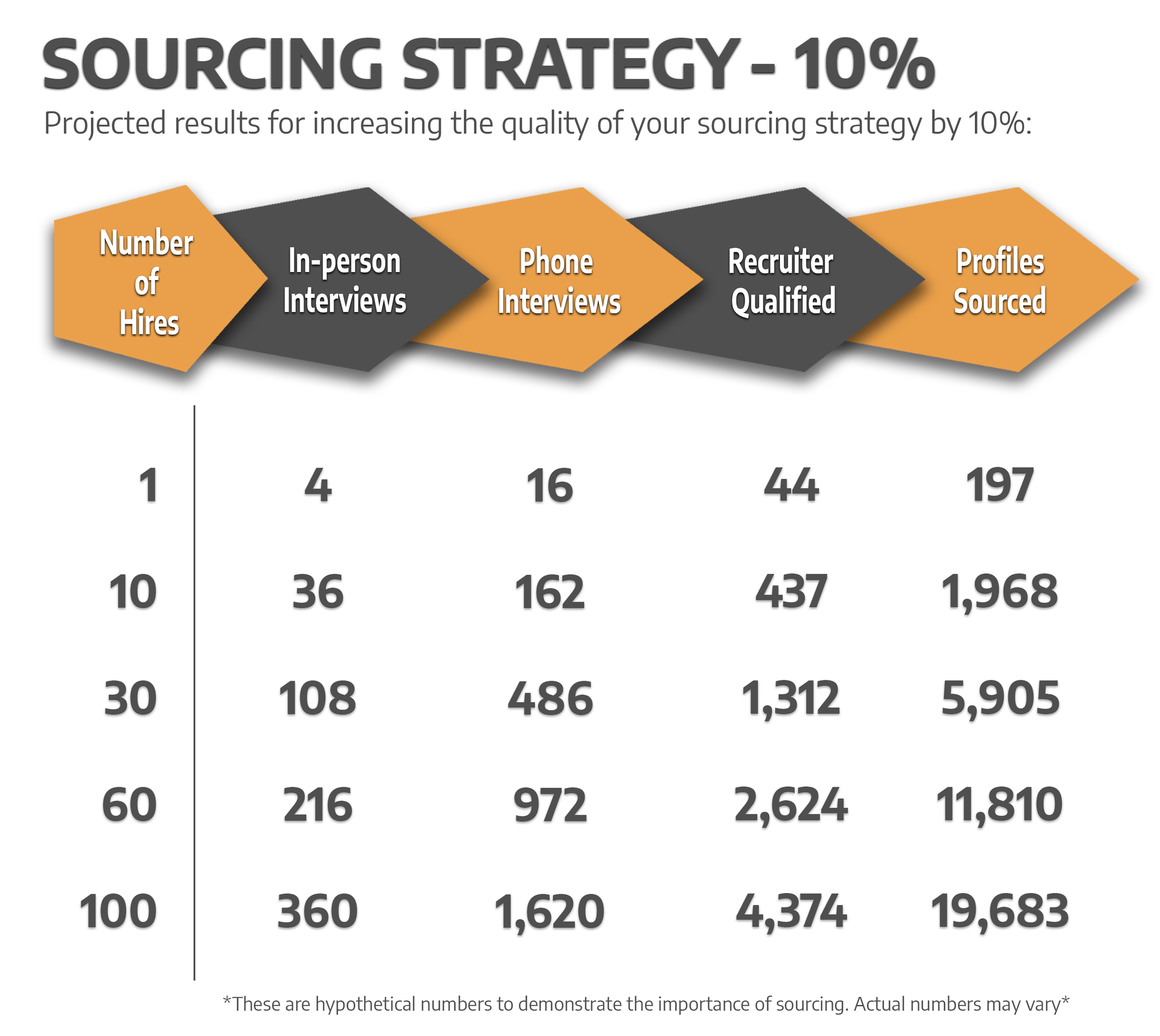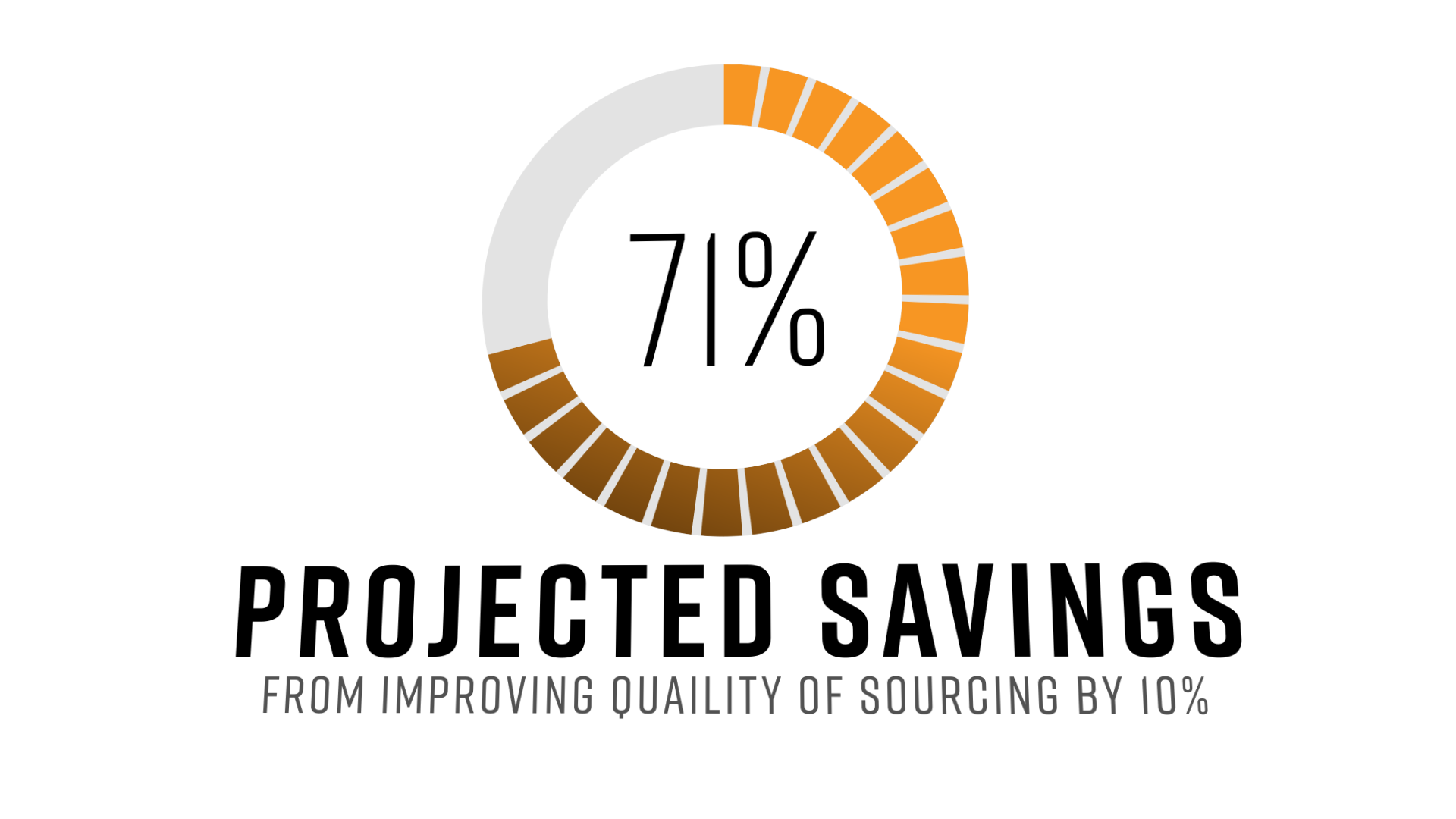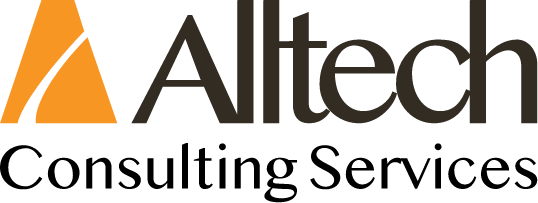“
Give me six hours to chop down a tree and I will spend the first four hours sharpening the axe.
What is Sourcing?
Let’s get blunt and straight to the point here, sourcing as a whole, is the first step to any talent acquisition strategy. It is the initial part of recruiting. Not only is it the first course of action, but probably the most important. Without sourcing, there is no recruiting. You can’t have a pb&j without the peanut butter.
Sourcing defines the actions you take through a variety of strategic methods in order to find qualified candidates. Sourcers are focused on the identification of top talent in order to fill the top of the candidate pipeline. Where then through proper assessment and engagement, recruiters can nurture those candidates towards a hire.
Having the right sourcing strategy will lead your talent acquisition efforts towards success straight from the get go. For example, when you go fishing, do you just throw your line in just any body of water? I mean yeah technically a swimming pool is filled with water, but have you ever seen one with fish in it? Unless you are playing carnival games, you need to think before you carelessly throw out a line. Think of sourcing as being a man with a plan. You’ll yield a higher quality catch when you fish where the fishes are.
When you are prepared, things more often than not, will go according to plan. At face value, investing in proper sourcing may appear as if you are putting more effort and money into things; but it will ultimately save you more in the long haul. Bringing us back to Abe’s notion on chopping trees; the sharper the blade on the axe, the deeper it cuts. When you allocate the right amount of resources on sharpening your sourcing strategy, the more quality candidates you’ll find.
How is Sourcing different from Recruiting?
These roles tend to fall into a grey area with one another. Mistakenly being used as interchangeable. Sourcing is not recruiting, and recruiting is not sourcing. There are some cases in which a recruiter may conduct sourcing duties in addition to their recruiting initiatives; that still doesn’t make it recruiting. The roles are much more defined than the majority may presume.
SOURCERS
Think of sourcers like hunters and candidates as the hunted. Their primary goal is to track and search for prey. From a distance they stand watching and waiting. Confirming if what they’ve found is worth it before making a move. Sourcers hunt for the candidates that make up the top of the funnel.
In order to be a great sourcer, you need to have a great understanding in technology, strong analytical skills and how to navigate a multitude of channels. Sourcing will never be a one stop shop. Everyone doesn’t hang out in the same places across the internet.
Therefore you need to be knowledgeable on how to coordinate your searches; following the right patterns, booelan search methods and using the right keywords. It is almost like a scavenger hunt. In order to get to the end game you need to go step by step, following each clue until you get to the prize. Which in this case would be quality candidates to add to your talent funnel.
RECRUITERS
Recruiters are more like farmers and candidates like seeds. The farmers job is to nurture the seeds until they grow into full crops ready for harvest. Recruiters nurture candidates from the top of the funnel, down the pipeline; ultimately to place them within a perfect fit opportunity.
After sourcers fill up the top of the funnel, recruiters pick up where they left off. They filter through the sourced talent. Engaging with the candidates, guiding them through the rest of the hiring process. Recruiters do all the talking. Utilizing their social and charismatic skills in order to snag the perfect candidate.
They need to know how to sell the opportunity. Just because a sourcer found a resume that fits best, it doesn’t necessarily mean that person is willing to change from their current position. The recruiters goal is to give an offer they can’t refuse, all while providing an excellent candidate experience.
Why is Sourcing important?
In order for any talent acquisition strategy to be successful, you need a strong base. A proper sourcing strategy is crucial because it provides that structure and gives your TA strategy legs to stand on. Sourcing gives you the talent in order to fill the pool that recruiters pull from.
Without talent, you can’t fill job orders, plain and simple. That is like buying a car and not putting gas in it. You can sit in the car all you want, but it won’t be able to start in order to get you to your destination.
It is important to have a sourcing strategy that is defined well, tested, and flexible enough that should you encounter any setbacks it still yields optimal results.
When does Sourcing play an important role?
Depending on the size of your company and it’s hiring needs, the level of sourcing efforts needed can vary. Coming from the Society for Human Resource Management’s (SHRM’s) 2016 Human Capital Benchmarking Report “The average cost-per-hire is $4,129, while the average time it takes to fill a given position is 42 days.” That is a lot of resources being allocated for just one hire. No matter where you stand, preparing and planning your sourcing efforts in advance will help combat those high costs and cut down on that time to hire.
FOR THE LITTLE GUYS
Companies with a relatively small hiring volume, developing an entire team dedicated to sourcing won’t be necessary. These are those instances where your recruiters would be performing sourcing duties along with the rest of their designated tasks.
FOR THE BIG BOYS
Companies with larger hire orders to fill, dedicating a team to sourcing alone is going to be money well spent. Especially if job orders require you to attract that hard to find talent. Those with niche and specialized skill sets.
No matter the size of your sourcing efforts or your hiring needs, implementing a strategic sourcing plan is something your company will benefit from.
To put things in perspective, Glassdoor says on average, each corporate job opening attracts 250 resumes. Of these candidates, four to six will be called for an interview and only one will be offered the job.
To go a bit further with at, we decided to crunched some numbers to give you a hypothetical visual as to how many profiles you might statistically need to source in order to make a solid hire.

It might not seem like a lot from the beginning, but in order to get those say 10 solid hires, sourcing over 3,000 profiles is quite the collection to tackle.
Now if you were to allocate your time wisely and develop a solid sourcing strategy numbers could drop significantly.

When you increase your efforts by only 10% you’re already dropping the number of profiles you need to source down to only 1,968!

That’s a projected savings of 71 percent! I don’t know about you, but i’m sure there are plenty of other better things to do with that extra time and money than source those extra profiles.
Sourcing Strategies
When developing a sourcing strategy that fits your needs it’s crucial to remember one thing…
DON’T SWIM AGAINST THE CURRENT!
I understand that innovation exists and it’s okay to test out new methods; but don’t make one strategy your sole course of action. Nobody likes a one trick pony. It’s possible you might get lucky and find something that sticks, but be smart on how you allocate your time and resources. Just because something works once doesn’t mean it will work in your favor tenfold.
USE THE RIGHT BAIT
In reference to fishing, when you want to catch a particular kind of fish , you need to use very specific techniques and lures. Certain fish can only be hooked with certain bait. If you are trying to attract a certain type of candidate, then you need to think about what they want. What is going to attract them to this opportunity.
Looking for millennials? For a generation that is set to be 75% of the workforce by 2025, you’ll need to speak their language. What kind of companies do they want to work for, what benefits do they need, etc. When considering a job opportunity, 60% of Millennials consider the most attractive perk to be growth opportunities.
When your methods are geared towards snagging anyone and everyone, you will connect with no one. All in all your strategy isn’t about you, the sourcer or recruiter. It’s about the needs of the clients and the candidates.
THINK BEFORE YOU SEARCH
One thing that can never be said enough, you need to chart your course or else you may get lost at sea. These are the initiatives that will compound, saving you that time and money in the long run. Start by defining your objectives. For example, let’s say you goal is to hire 30 full stack developers.
To find them, you need to get into the mind of a full stack developer. Understanding what technology they utilize or even finding out what online communities they engage.
When hunting for for this role here are some questions that you should ask yourself:
- What kind of skill keywords would you need to plug in?
- Are there any specific or unusual job titles this skill set might carry?
- What would their job duties include?
- Is this role for niche or specialized talent?
Next you need to identify what sourcing channels you will utilize to begin your search:
- Job Boards / Traditional Databases
- Aggregated Social Resume Databases
- Networking / Social Platforms
- Referrals
- Search
- Boolean/X-ray Sourcing
- Contact Information Finder
- Email marketing
- Applicant Tracking Systems
- Hiring Platforms
Ask yourself what challenges you may encounter:
- Limited talent available for the position?
- How practical is your search going to be?
- What is the best way to approach talent for this role?
METRICS TO FOLLOW
When it comes down to testing methods, you need to have certain metrics to follow in order to get a sense as to whether or not you’ve been successful. The proof is in the pudding, numbers don’t lie.
Time
Time management is the key in order to get work done realistically and efficiently. You should be measuring the amount of time it takes, with each new requisition, to source for candidates. When you have a sense of how long these efforts are taking, you can then assess and readjust in accordance with expectations.
Cost
It’s important to track where your money is going. Whether it is being spent on advertisements or engaging with candidates, if you’re not watching what you’re spending you might as well be tossing your dollars in the paper shredder.Not all roles are created equal, so costs can vary here depending on the complexity of the position. In relation to time, monitoring the cost to source each hire will give you feedback in order to readjust your methods to be as efficient as possible.
The Source
Keeping track of where you found certain candidates is an extremely valuable metric to follow. More likely than not, you will encounter the need to source for a similar role again. Keeping track of your success in the past will give you that jumpstart. This way instead of starting out empty handed, you will always have a sense of which direction you can go. Assisting in saving you time and money.
New Hire Retention
So you’ve sourced, recruited, and got the perfect candidate hired for the role. Things don’t stop there now that you’re services has technically ended. Even though a candidate has gotten through the entire process and even landed the job, a way to measure the success of your efforts is to see the if the candidate stays with the company long-term. Giving you a sense as to whether or not your truly met the expectations for both parties.
Offer Acceptance
Keeping tabs on this metric will contribute to whether or not your sourcing strategy is effective. If you are finding perfect candidate after perfect candidate, and the offer acceptance ratio is statistically too low, it might be time to reflect. Naturally, not everyone is going to accept your offer. There are too many variables in life that contribute for one to decline. Numbers don’t lie, so your methods might come into question when the statistical probability seems off.
Diversity
Now everyone, whether they know it or not, has a little bit of bias in life. Personal opinions and preferences are hard to track, since the majority tends to be unaware of them. A great metric to combat this unconscious bias is through monitoring the gender balance. You should review and be aware of the current gender balance of employees and candidates when sourcing. This way you can plan and properly coordinate your efforts towards diversity and inclusion in the workplace.
Overall, metrics are simply there to keep you on track. Giving you a visual as to what is and what’s not working. If you don’t know where you are going, how else are you supposed to know if you’re succeeding.
Tools and the Future of Sourcing
From the wise words of one of our mentors “Today is the slowest change of pace in your life.” This rings true for any business. From the CEO’s down to their talent acquisition and sourcing teams. The pace of change is lighting speed. Everyday is an opportunity to be better than yesterday.
Soon enough, if not already, the simple combination of just strong analytical skills and our current grasp on technology won’t be enough. To establish even better results, machines will be used to start leveraging artificial intelligence and natural language processing to make our sourcing and recruiting initiatives more automated.
Not saying that all is lost and that your sourcing efforts will be impaired right now, but we have to make sure we stay in line with the times. We need to be flexible, keeping current with newer inventive tools and strategies. This way our efforts are ever growing, developing, and producing results.
Today we have fragmented tools at our disposal for a multitude of objectives. Eventually integrative technology will play a role in consolidating, making those tools more effective and efficient all in one place.
We could see technologies like blockchain to help us better connect and reach out to Talent. Even augmented or virtual reality can contribute a different role into our reach. Call dialers that are used by Tele Markers will be doing outreach and automated voice systems will be able to answer questions for candidates anytime and anywhere. There is so much out there, I will have to write a whole other blog about it.
When it comes to assistive technology, there is so much innovation out there just waiting to be discovered. The best way to stay on top of your sourcing, is to keep your mind open and do your research. As a good sourcer you need really understand the trends, live up to candidate expectations, and be in the know of where the candidates will be engaging.
With that being said, my friend, stay proactive.





